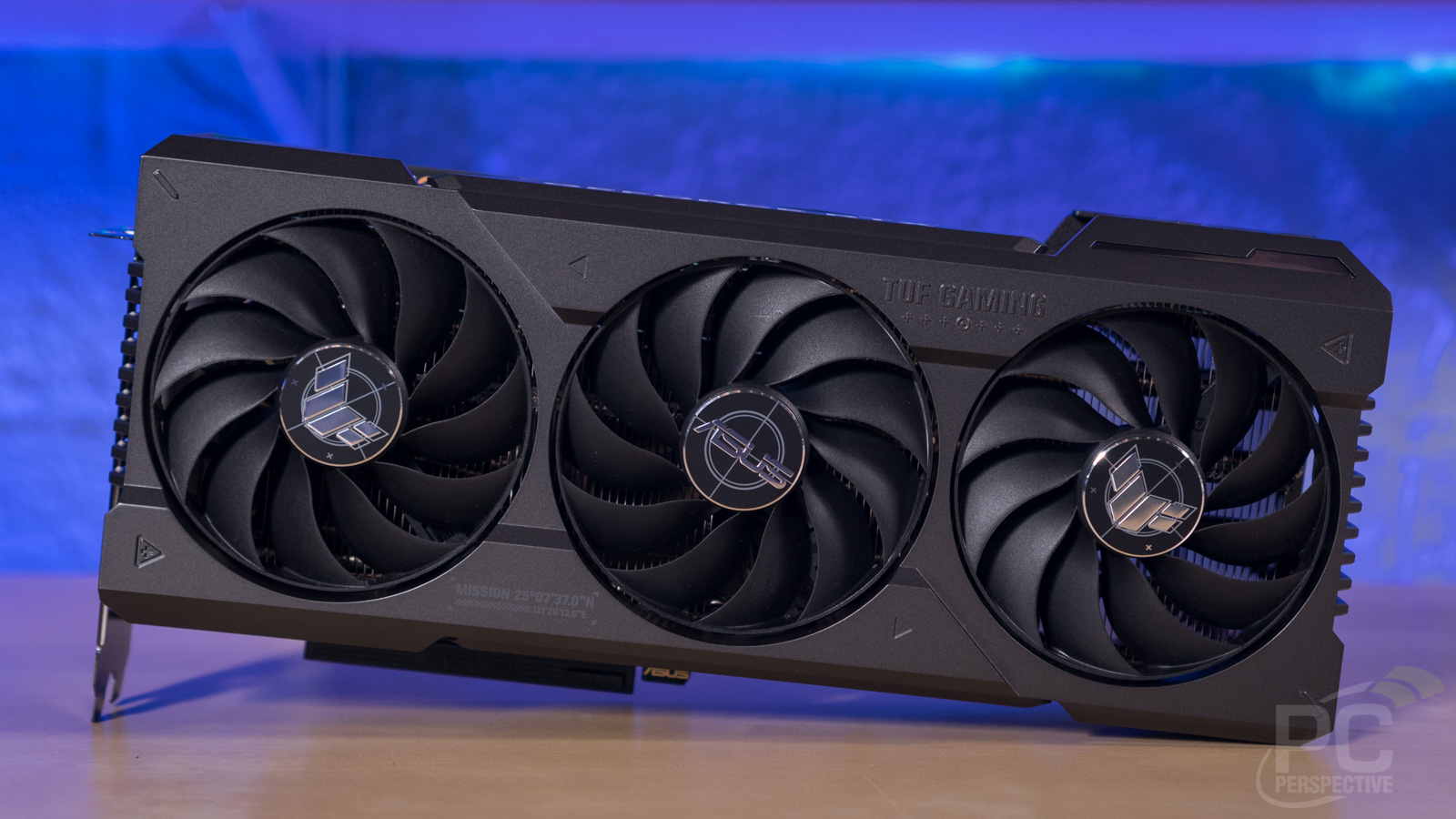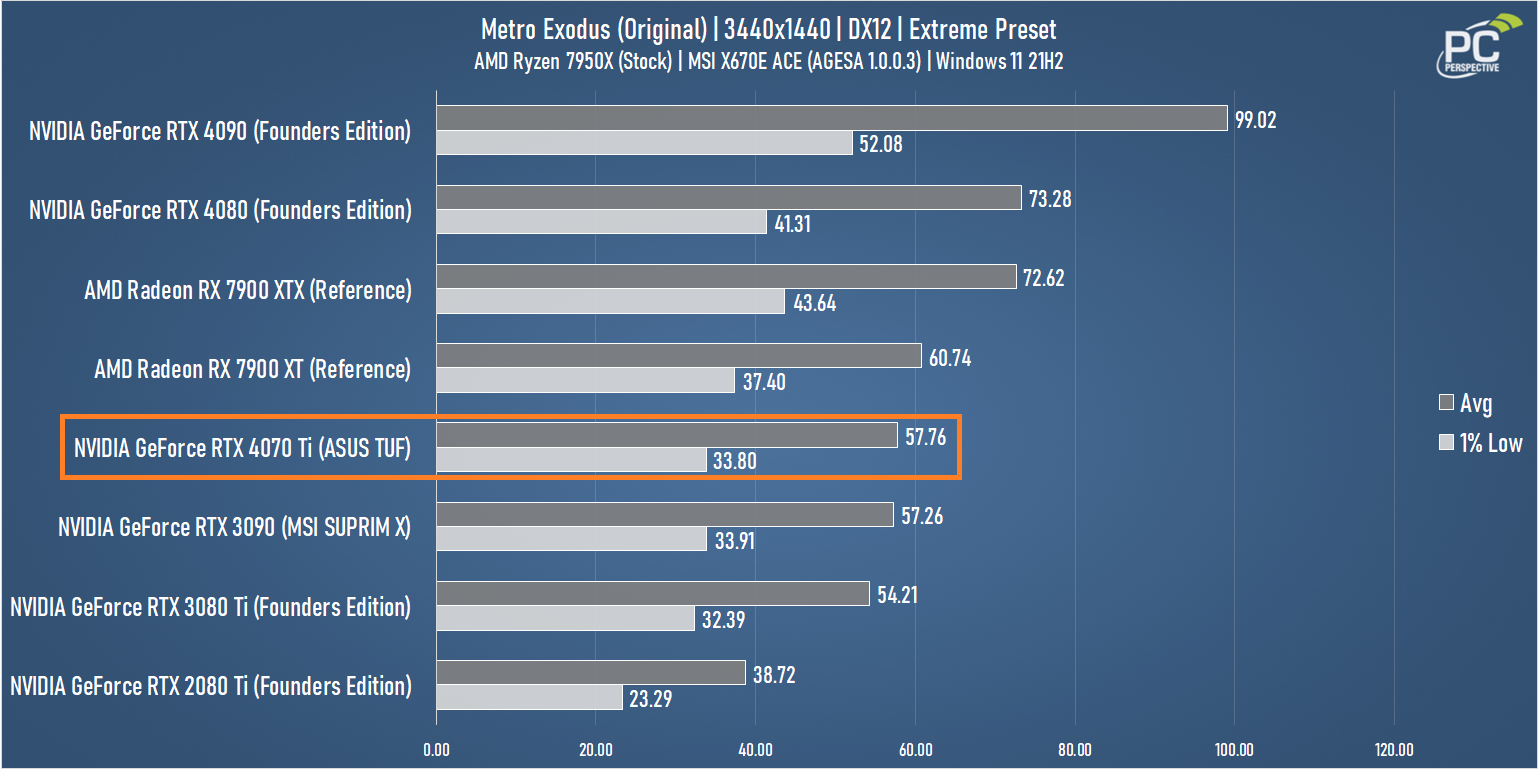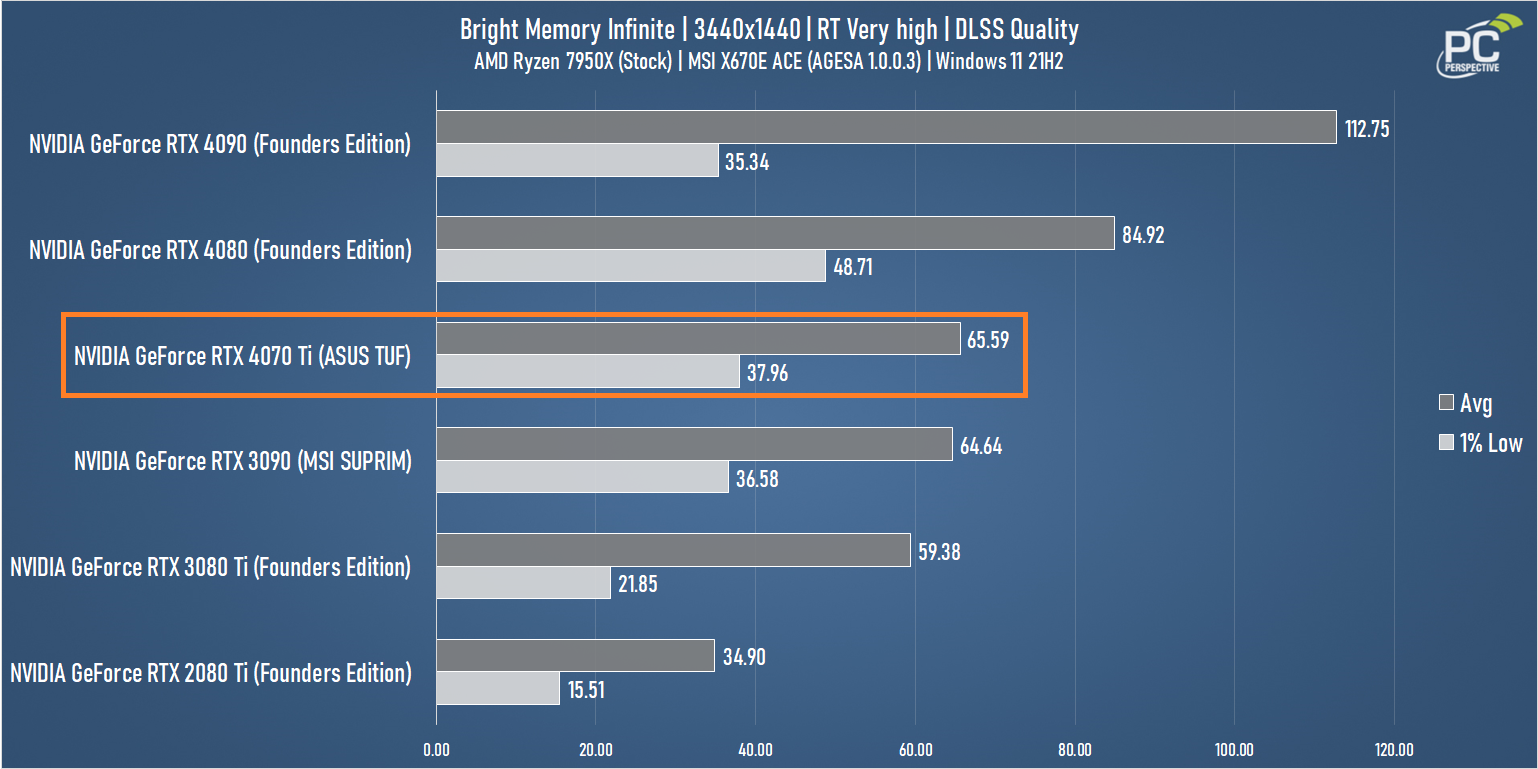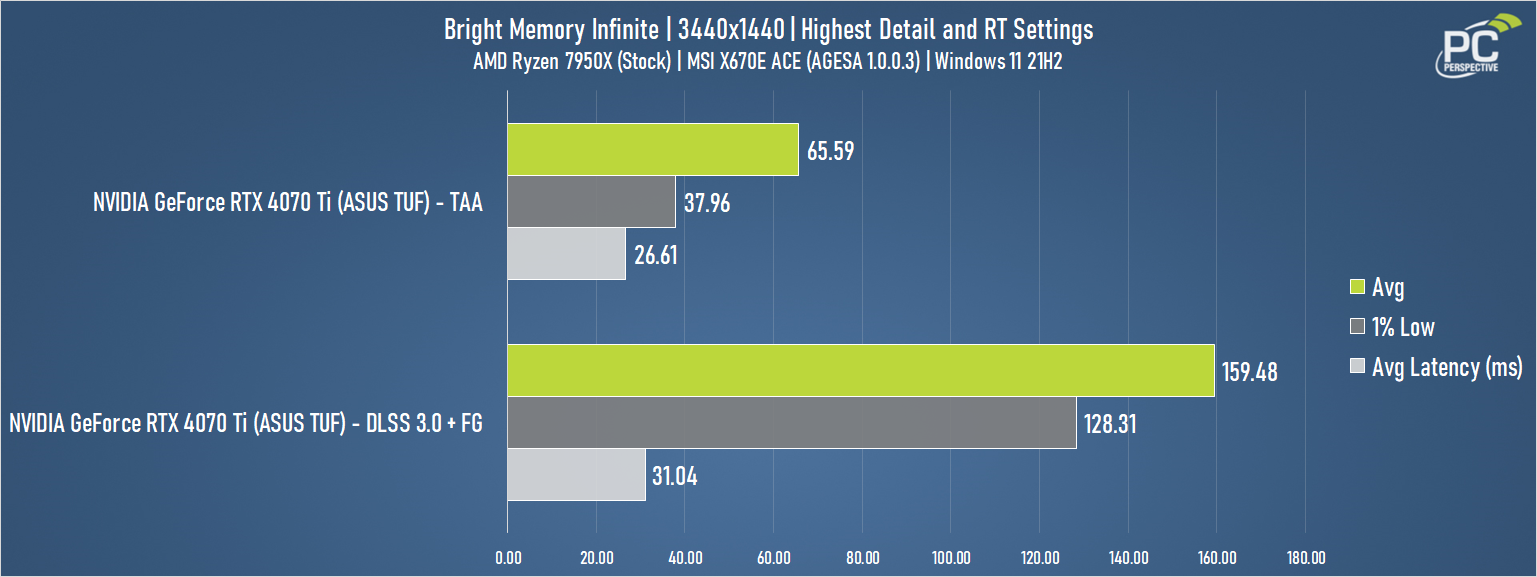NVIDIA GeForce RTX 4070 Ti Review – Featuring ASUS

We check out the ASUS TUF RTX 4070 Ti O12G GAMING card
CES is upon us, and, for the first time since the GeForce RTX 2060 in 2019, NVIDIA is launching a new GPU at Consumer Electronics Show. It is of course the GeForce RTX 4070 Ti, which was announced yesterday. We received an ASUS card in advance, and can share performance numbers with you today.
NVIDIA has given the new GPU a $799 MSRP, and it fits into the product lineup just where the “unlaunched” RTX 4080 12GB would have been. This $799 MSRP is $100 less than the product it replaces, as the RTX 4080 12GB had been announced at $899.
Let’s get on with the review.
Specifications
Here’s a look at the current RTX 40 Series family – plus the RTX 3090 Ti that this new GPU apparently outperforms:
| RTX 4090 | RTX 4080 | RTX 4070 Ti | RTX 3090 Ti | |
|---|---|---|---|---|
| GPU | AD102 | AD103 | AD104 | GA102 |
| Architecture | Ada Lovelace | Ada Lovelace | Ada Lovelace | Ampere |
| SMs | 128 | 76 | 60 | 84 |
| CUDA Cores | 16384 | 9728 | 7680 | 10752 |
| Tensor Cores | 512 (4th Gen) | 304 (4th Gen) | 240 (4th Gen) | 336 (3rd Gen) |
| RT Cores | 128 (3rd Gen) | 76 (3rd Gen) | 60 (3rd Gen) | 84 (2nd Gen) |
| Base Clock | 2235 MHz | 2205 MHz | 2310 MHz | 1670 MHz |
| Boost Clock | 2520 MHz | 2505 MHz | 2610 MHz | 1860 MHz |
| Texture Units | 512 | 304 | 240 | 336 |
| ROPs | 176 | 112 | 80 | 112 |
| Memory | 24GB GDDR6X | 16GB GDDR6X | 12GB GDDR6X | 24GB GDDR6X |
| Memory Data Rate | 21 Gbps | 22.4 Gbps | 21 Gbps | 21 Gbps |
| Memory Interface | 384-bit | 256-bit | 192-bit | 384-bit |
| Memory Bandwidth | 1 TB/s | 716 GB/s | 504 GB/s | 716 GB/s |
| Transistor Count | 76.3B | 45.9B | 35.8B | 28.3B |
| Die Size | 608 mm^2 | 379 mm^2 | 295 mm^2 | 628 mm^2 |
| Process Tech | TSMC 4N NV Custom | TSMC 4N NV Custom | TSMC 4N NV Custom | Samsung 8nm NV Custom |
| TGP | 450W | 320W | 285W | 450W |
| Launch Price | $1599 | $1199 | $799 | $1999 |
The RTX 4070 Ti offers 7680 CUDA Cores, with 240 TUs and 80 ROPs. The TU and ROP count are repeated in the ray tracing hardware, as there are 240 (4th Gen) Tensor Cores and 80 (3rd Gen) RT cores.
Really, memory bandwidth should be the only thing holding this card back, as it offers just a 192-bit interface – though the memory is 21 Gbps GDDR6X. Thus, the 12GB of video memory offers up to 504 GB/s in total bandwidth. Helping matters is the large L2 cache, which is ~48MB with this GPU.
The ASUS TUF Gaming Card
ASUS introduced GeForce RTX 4070 Ti models from both their Strix and TUF Gaming lineups yesterday, with our TUF Gaming sample offering a slightly more case-friendly design of the two given its shorter length.
While shorter than the new Strix design (336 mm), the card is still 305 mm / 12 inches in length, so you will need to check your enclosure’s GPU clearance. This is a 3.25 slot, triple-fan cooler design, featuring ASUS’s new 11-blade Axial-Tech fans.
Via ASUS:
The unibody die-cast shroud shares the same structural strength as our TUF Gaming GeForce RTX 4080 and 4090 cards, while a wide vent on the backplate improves airflow compared to previous generation models. The TUF Gaming GeForce RTX 4070 Ti also offers the same Dual BIOS switch and a redesigned ARGB TUF logo along the shroud for a touch of flair, alongside the military-grade capacitors and Auto-Extreme manufacturing quality all TUF cards are known for. If you want a durable card that’ll prove its worth time and time again, the TUF Gaming GeForce RTX 4070 Ti stands firm in its commitment to long-lasting gaming performance.
Performance Testing
I have fired up the AMD X670E platform once again, powered by a Ryzen 9 7950X processor and 32GB of DDR5-6000 CL30 memory. As always, each benchmark result on the charts is the average of three identical runs.
| PC Perspective GPU Test Platform | ||||||||
|---|---|---|---|---|---|---|---|---|
| Processor | AMD Ryzen 9 7950X (Stock) | |||||||
| Motherboard | MSI MEG X670E ACE BIOS v1.25 Beta AGESA ComboPI 1.0.0.3 Patch A Resizable BAR Enabled |
|||||||
| Memory | 32GB (16GBx2) G.Skill Trident Z NEO DDR5-6000 CL30 | |||||||
| Storage | SK Hynix Platinum P41 2TB NVMe SSD | |||||||
| Power Supply | be quiet! Dark Power Pro 12 1500W | |||||||
| Operating System | Windows 11 Pro, 21H2 | |||||||
| Drivers | GeForce Game Ready Driver 526.72 – 527.62 Adrenalin 22.40.00.57 |
|||||||
3DMark Benchmarks
Beginning with the synthetic results, we look at three 3DMark tests: Time Spy Extreme, Port Royal, and Speed Way.
Time Spy Extreme is a DirectX 12 raster benchmark, rendered at 3840×2160. If we stopped here, it would be obvious by NVIDIA is offering this GPU with an MSRP which is currently $100 lower than AMD’s Radeon RX 7900 XT. Will this result hold up? Well, let’s see what happens when we move up to DirectX 12 Ultimate:
The performance story between the RX 7900 XT and the RTX 4070 Ti is going to completely depend on the presence of DXR. And this isn’t limited to synthetic tests.
3440×1440 Ultrawide Game Benchmarks
First, let’s look at results from Metro Exodus – the original version (no ray tracing is enabled):
A victory for the Radeon RX 7900 XT here, with an average 3 FPS advantage over the GeForce RTX 4070 Ti in this test. Comparing the 4070 Ti to other NVIDIA cards, we find that it is almost identical in performance to our RTX 3090 – though it is a factory-overclocked MSI SUPRIM model. It is possible that the 4070 Ti is equal to the 3090 Ti as NVIDIA indicated, but this will probably be title-dependent.
And now we look at the Enhanced Edition of Metro Exodus, at the same resolution/preset:
Sure enough, in Metro Exodus Enhanced Edition the RTX 4070 Ti leapfrogs up the chart to lead the RX 7900 XT, and is very much at the “faster than a 3090 Ti” performance level here. Or at least I assume so, as I have to estimate this relative to the performance of our RTX 3090 SUPRIM X, as we were not sampled a GeForce RTX 3090 Ti.
Next we will look at results from a very AMD-friendly title, DiRT 5. This is my best-case test for the Radeon RX 7900 Series, and obviously they have an excellent showing here:
In DiRT 5 the Radeon RX 7900 XT was 12% faster than the RTX 4070 Ti (and the RX 7900 XTX is roughtly 4% faster than the RTX 4080). Not a massive victory, but another example of AMD’s advantage in a primarily raster-based title (there are RT shadows, for whatever that’s worth).
Sticking with racing games, let’s check out F1 22. This time the settings will favor NVIDIA, as this has quite a few ray traced effects enabled at its highest detail level:
I expected the RTX 4070 Ti to out-perform the RX 7900 XT in this test, but it didn’t manage to match the performance of the RTX 3090 SUPRIM X this time.
For a final look at a raster-based game benchmark, here’s Cyberpunk 2077, version 1.61, at its Ultra preset with no RT or resolution scaling:
This is a solid victory for AMD – until you look at 1% lows. Not every outlet reports this issue with this particular title from these Radeon cards, but not every outlet re-tested all of their Radeon cards on version 1.61 of this game on an X670E platform running this version of Windows (etc. etc.). Take this for what you will, but I re-tested the heck out of this game and these are the results.
Anyhow, here’s how things look for the RTX 4070 Ti in a dedicated RTX benchmark:
We are back into that faster-than-a-3090-but-maybe-not-a-3090Ti territory with this test, but I’m assuming it would be tied with the Ti at best here. This benchmark uses the older DLSS 2.0, however, and I have access to the latest version of this game which supports DLSS 3.0.
I performed some initial testing to see how the game runs on this new GPU, first using TAA and then with DLSS 3.0 + Frame Generation. Now, FG is not a topic that seems to endear people to NVIDIA, but it did raise my average FPS in this game up to very high levels – while incurring a modest latency penalty:
Up to this point I have ignored the marketing claim NVIDIA made during their announcement, that this RTX 4070 Ti could be up to 3x the speed of the RTX 3090 Ti. That is clearly factoring in the 40 Series exclusive DLSS 3.0 Frame Generation, and as you can see from the above result it was possible to get well over 2x the framerate in this game by enabling it (NVIDIA cited 3x perf with Cyberpunk 2077’s “RT Overdrive” mode in their chart).
I will have to re-visit Bright Memory Infinite with the rest of the RTX family in the future, as I was able to come up with a repeatable in-game run that yielded similar enough results to mostly satisfy my obsessive need for precision benchmarking.
Power Draw
Contrary to some rumors, the RTX 4070 Ti is only a 285W TGP GPU. When comparing the direct power measurements we find that this card is very well behaved, and consumes considerably less power than the RX 7900 XT. The chart below shows logging during a run of 3DMark Speed Way:
Power was generally below NVIDIA’s rated TGP of 285 watts for this GPU, though our ASUS sample did spike slightly above this, but only hit a max of 294 watts. The AMD reference RX 7900 XT draws quite a bit more; even if we ignore the single spike up to 389W it still hit 340 – 350 watts for much of the test, with spikes up to 360 watts.
Ada continues to be an impressively efficient architecture, so you can safely ignore the hype about power draw this generation. Sure, the RTX 4090 is a 450W card, but the R9 295×2 was a 500W card a decade ago. I think it’s time to find a new narrative.
Pricing – Let’s Stop Complaining About It
While it ended up being $100 lower than we anticipated, the GeForce RTX 4070 Ti’s $799 price will still anger a lot of people. We have a xx70 card with a higher price tag than the last-gen xx80 card, and it doesn’t matter what the performance is (apparently); people will still be outraged by this.
I could theorize that once an RTX 4060/4060 Ti cards is available (in what I hope will be the under-$500 segment), we may finally see the RTX 30 Series put to bed – and with it the price pressure on these higher-performing new parts. Having a $699+ RTX 3080 does not help, but if the market votes against the status quo then who knows what might happen with pricing.
I am, however, growing increasingly tired of the current-gen pricing complaints. AMD was selling their flagship Radeon RX 5700 XT for just $399 a few years ago, and the GTX 1080 Ti was $699. I remember those days, too. However, I don’t think prices are coming down any time soon, unless Intel’s next GPU kicks major ass or AMD decides to start a price war.
Maybe, just maybe, we can accept that high-end GPUs are expensive niche products right now (as they once were), and the era of $699 flagships is over. Things cost more than they used to now, as I keep learning every time I go shopping for anything. If expensive computer add-in boards don’t sell then decisions will have to be made about their price, and the economic viability of continuing to produce them.
Enough about pricing. It’s annoying to pay more for things. Every single thing at the hardware store is double what I last paid for it whenever I need to fix something around the house. No one wants to hear me complain about the cost of PVC pipe or electrical wire, but I have started to accept that the buying power of a dollar is about half of what it used to be.
Final Thoughts
If you haven’t stopped reading in outrage over my refusal to join the angry pricing mob, welcome! Readers will vote with their wallets, and if you think NVIDIA – or AMD – is charging too much for this level of performance this generation, then don’t buy one of those products.
Looking only at the current competitive landscape, this card is closest in performance to AMD’s Radeon RX 7900 XT. Our reference RX 7900 XT offers higher traditional raster performance, but If you play games that use real-time ray tracing, the GeForce RTX 4070 Ti is generally faster (and I’m not talking about when DLSS or any other resolution scaling in effect). AMD’s card is – currently – $100 more, which makes this choice a lot easier.
Simply put, NVIDIA is offering a better overall product at $799 than AMD is currently offering at $899, once ray tracing is factored in. And if you don’t care about ray tracing, NVIDIA is still competing on value. The $799 MSRP was a smart move, and will probably nudge AMD into lowering the 7900 XT’s price (to the level they probably intended all along, #jebaited).
The ASUS TUF card we tested performs well, and is very cool and quiet thanks to the large cooler design
The exact ASUS TUF card we reviewed is model TUF-RTX4070TI-12G-GAMING, and it carries a $50 premium over the baseline $799 MSRP, retailing at $849.99 USD. So does this slim $50 disparity change the comparison with a RX 7900 XT at $899? Slightly. But after testing both I would still take the ASUS TUF card over a reference RX 7900 XT, unless AMD lowers their price.
Bottom line, NVIDIA’s RTX 4070 Ti is a compelling alternative to AMD’s Radeon RX 7900 XT, with faster performance in DXR titles even without DLSS. If you still don’t care about real-time ray tracing, the Radeon card provides higher performance in games without RT, but costs more and draws quite a bit more power.
Review Disclosures
This is what we consider the responsible disclosure of our review policies and procedures.
How Product Was Obtained
The product was provided by NVIDIA for the purpose of this review.
What Happens To Product After Review
The product remains the property of NVIDIA but is on extended loan for future testing and product comparisons.
Company Involvement
NVIDIA had no control over the content of the review and was not consulted prior to publication.
PC Perspective Compensation
Neither PC Perspective nor any of its staff were paid or compensated in any way by NVIDIA for this review.
Advertising Disclosure
NVIDIA has not purchased advertising at PC Perspective during the past twelve months.
Affiliate Links
If this article contains affiliate links to online retailers, PC Perspective may receive compensation for purchases through those links.

























I’ll (probably) always be interested in technology and maybe this is just me but to me the enthusiast DIY space of PC building has become pretty uninteresting to me. CPUs and GPUs continue to get more powerful, solid state storage gets faster and cheaper, but innovation and design have kinda stagnated over the past several years. Things have just become more power hungry and difficult to cool. The price of hardware (fair or unfair) dosn’t help anything but I think its time the industry throws off the shackles of ATX takes some steps revision what a enthusiast PC looks like.
Meh, the world is messed up and talking about prices is getting boring. Good to see a reasonable power draw, plus the transistor counts never fail to blow my tiny mind. It’s not blowing my skirt up though.
I voted with my wallet and bought a PS5… the prices are too high. The sweet spot for many generations was the xx70 card for ~$300. Now it’s $799? Nope. I’ll wait until they come down and if they don’t I won’t ever buy a current gen card again.
It is impossible not to at least consider the pricing. Yes, benchmark it and compare it to its peers on its merit. But talking about the actual value proposition is still important.
A 70 class card with 60 class memory specs and > 80 class pricing is a weird combination, and a problem.
And yes, everything costs more, but the price increases of these cards compared to what the MSRP was supposed to be in the previous generation is still much higher than the actual rate of inflation.
If the 4080’s price was calculated by taking the 3080’s $700 MSRP and adjusting for inflation, you arrive somewhere around $850-$900. Not $1200. I can understand needing to account for inflation. Not an additional 20% on top of inflation.
Judging cards by an arbitrary ‘class’ is frankly ludicrous. Judge cards based on price and performance, not colour and branding or shiny stickers or silly names or ‘bigger number more better’ spec-sheet naval-gazing.
thank you for including 1440P ultrawide. I got the 4080 for around $1050 and I think for that price and UW resolution, it’s a good pairing.